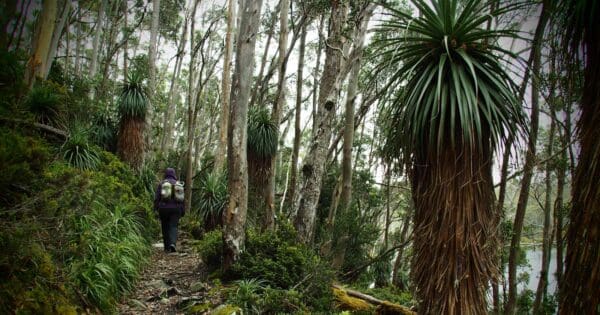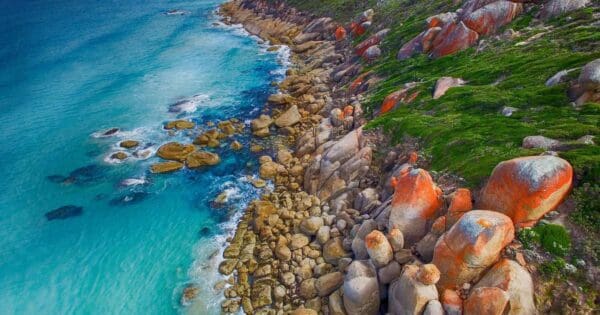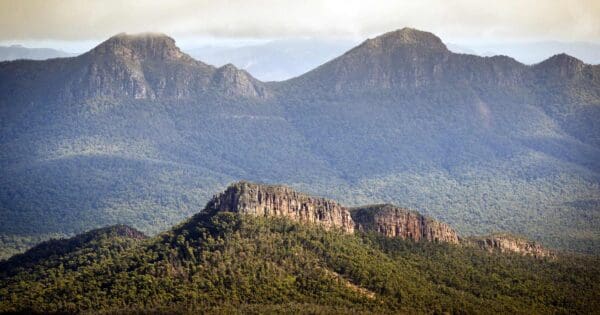Nestled on Tasmania’s stunning east coast, Freycinet National Park is a breathtaking sanctuary of natural beauty, where ancient landscapes meet the vast, azure waters of the Tasman Sea. This natural wonder, with its iconic landscapes and captivating views, is one of Australia’s most cherished destinations for nature lovers and adventure seekers alike. Freycinet offers an unparalleled experience that combines the raw majesty of rugged granite peaks with the serene elegance of pristine beaches—a must-visit for anyone seeking adventure, relaxation, and a true connection with nature.

A land sculpted by time
Freycinet’s dramatic landscape has been over 400 million years in the making. The park is defined by its two eroded blocks of pink granite—the Hazards and the peninsula that houses Mount Graham and Mount Freycinet—connected by the slender sand isthmus that forms the world-renowned Wineglass Bay. These granite formations, bathed in a soft pink hue at sunrise and sunset, provide a stunning backdrop to the park’s many natural wonders. The most famous of these is Wineglass Bay, often hailed as one of the most beautiful beaches in the world. Its perfectly curved white sand beach, framed by the rugged Hazards mountains, contrasts sharply with the crystal-clear, turquoise waters. This iconic view has become a symbol of Tasmania’s wild beauty and is a must-see for anyone visiting the island.

Wineglass Bay: The crown jewel
While Wineglass Bay is the crown jewel of Freycinet, the park is rich with diverse landscapes and activities that cater to all levels of adventure. Whether you’re looking to embark on a challenging trek, enjoy a leisurely stroll, or simply relax on a secluded beach, Freycinet has it all.
Wineglass Bay Lookout is one of the most popular hikes in the park, offering a relatively easy 60-90 minute return walk that rewards visitors with a panoramic view of the bay. For those seeking a more immersive experience, the Wineglass Bay and Hazards Beach Circuit is a 12.5 km trek that takes you down onto the sands of Wineglass Bay, across the isthmus to Hazards Beach, and back along the coastline beneath the Hazards mountains.
For the more adventurous, the Mount Amos hike offers a challenging climb up steep granite slabs, but the effort is well worth it for the extraordinary view from the summit, where you can gaze down upon Wineglass Bay and the surrounding peninsula. The Freycinet Circuit, a two- to three-day loop around the peninsula, provides an opportunity to fully immerse yourself in the park’s diverse landscapes, with campsites at Hazards Beach, Cooks Beach, and Wineglass Bay offering a chance to rest and soak in the tranquility of your surroundings.
But there’s more to Freycinet than this one iconic scene. Venture further, and you’ll discover a diverse landscape where each corner offers a new experience.
Adventures await: Explore by land and sea
Freycinet is not just about the land; its coastal waters are equally captivating. The park’s bays and beaches invite you to swim, snorkel, dive, or kayak, offering a chance to explore the vibrant marine life beneath the surface. The clear waters are home to a variety of marine species, from colorful fish and playful seals to the majestic southern right whales that visit the area during the winter months.
Kayaking around the Freycinet Peninsula is a particularly popular activity, with guided tours allowing you to paddle across the toes of the Hazards, explore secluded beaches, and take in the stunning coastal scenery from a unique perspective. For a more leisurely experience, a Wineglass Bay Cruise offers the chance to sail out from Coles Bay, round the tip of the peninsula, and enjoy lunch in the tranquil setting of Wineglass Bay itself.

Wildlife and conservation
The Freycinet Peninsula is renowned for its stunning coastal scenery and diverse wildlife. The waters off the Freycinet Peninsula are a notable highlight, regularly visited by southern right whales during the winter months. On land, you might encounter Bennett’s wallabies, pademelons, and echidnas, while seals are often spotted resting on rocks.
The park plays a crucial role in conservation due to its diverse landscapes and rich biodiversity. Over 500 plant species have been recorded within the park, including more than 80 species of orchids. Many of these species have restricted distributions and are protected under the Tasmanian Threatened Species Protection Act 1995 (TSP Act). The varied vegetation in Freycinet is indicative of the park’s temperature ranges and precipitation levels, contributing to its ecological richness. Wildflowers add vibrant color to the landscape throughout the year.
Birdwatchers will find Freycinet a paradise, with a range of species from small nectar-feeding birds to large birds of prey. From the Wineglass Bay and Cape Tourville lookouts, you might spot white-bellied sea-eagles gliding overhead or Australasian gannets diving into the ocean. The Moulting Lagoon, a RAMSAR wetland sanctuary, is especially important for migratory birdlife, including black swans and various waterfowl.
Mammals such as the Red-necked Wallaby, Eastern Quoll, Brushtail Possum, and Sugar Glider roam freely in the park. Reptiles like lizards, skinks, and snakes are also present. Cetaceans such as Southern Right Whales, Humpback Whales, and Bottlenose Dolphins can be seen in the bay, feeding or taking rest.
It’s important to respect the park’s wildlife; feeding animals is strictly prohibited, and fines apply for violations. For bird enthusiasts, picking up a bird spotting guide from the park’s entry station is highly recommended. Freycinet National Park’s ecosystems, from coastal forests to granite mountains, create habitats for a wide variety of plants and animals, underscoring its significance in conservation efforts.

Rich in cultural history
Freycinet’s natural beauty is matched by its rich cultural heritage. The park lies within the traditional lands of the Oyster Bay nation, which consisted of an estimated 600-700 people. Their territory extended from the Derwent Estuary up the east coast to the Fingal Valley and westward to the Midlands. This connection to the land is deeply rooted, with the Freycinet Peninsula and Schouten Island being part of the area of the toorerno-maire-mener clan within the Oyster Bay nation.
Significant Aboriginal sites are found along the coastlines, dunes, and estuaries of Freycinet. These include shell middens, rock quarries, rock shelters, and stone artefacts. The camping ground at Richardsons Beach is located adjacent to one of the most extensive shell middens on the east coast, a highly significant cultural resource. These sites hold a strong and continuing connection to the Tasmanian Aboriginal community, and visitors are encouraged to respect and appreciate these areas of global significance.
European settlement introduced whaling parties, tin and coal miners, and pastoralists to the Freycinet Peninsula. The remnants of these early industries, including old mine shafts, abandoned farmers’ huts, and whalers’ camps, contribute to the park’s rich cultural heritage.
The majestic beauty of Freycinet’s granite mountains and sandy beaches has long been admired by naturalists, artists, and writers. In recognition of its natural and cultural significance, the area was reserved as a national park in 1916, making it the oldest national park in Tasmania, alongside Mount Field National Park. Today, Freycinet stands as a testament to the enduring connection between people and place, a connection that continues to be honored and preserved.
Indulge in local delights
Whether you’re visiting for a day or planning a longer stay, Freycinet National Park offers a wealth of activities and experiences that will leave you in awe of Tasmania’s natural wonders. The nearby coastal town of Coles Bay serves as the perfect base for your explorations, with its sheltered waters, friendly locals, and easy access to the park’s many attractions.
At the end of a day filled with adventure, there’s nothing better than unwinding with a picnic on the beach, watching the pink granite of the Hazards glow in the setting sun. If you’re lucky, you might even spot one of the park’s most famous residents—the Tasmanian devil—making an appearance as dusk falls. After a day of exploration, relax with some of the local fare. Tasmania’s cool climate wines and fresh seafood are a perfect way to unwind. Whether you’re enjoying a woodfired pizza on the beach or dining at one of the area’s luxury lodges, the flavors of the east coast are sure to delight.

Plan your Freycinet adventure
Before you begin your exploration of Freycinet National Park, a stop at the Freycinet Visitor Centre is highly recommended. Located at the entrance to the park, the centre issues park passes and provides valuable insights into the park’s history, geology, and ecology. It also sells outdoor equipment, clothing, natural history books, and a variety of souvenirs. The centre is open daily from 9 am to 4 pm, year-round, and is staffed with friendly personnel who can assist with enquiries and offer tips on the best spots to visit based on the season and your interests.
A parks pass is required for entry to Tasmania’s national parks, and there are several options available, including a 1-day pass exclusive to Freycinet and an annual pass that covers all National Parks of Tasmania. Additionally, the visitor centre provides access to filtered and chilled water, which is essential as drinking water is scarce within the park. There are also water refill stations at Honeymoon Bay and the Wineglass Bay Walking Tracks Car Park.
For convenience, the centre’s shop includes a selection of products such as postcards, park passes, clothing, and natural history books. During peak seasons, the centre also hosts seasonal activities, including guided walks and presentations.
Facilities within the park include electric barbecues, picnic tables, and toilets at Honeymoon Bay and Ranger Creek, with additional toilets available at the Walking Tracks Car Park. Please note that drones are not permitted in Tasmanian national parks or reserves, and visitors are requested to take all rubbish with them when leaving.
Accessibility
Freycinet National Park is committed to ensuring that all visitors have a positive experience. Here are some details to help plan your visit if you have mobility needs:
- Visitor Centre: The visitor centre at the park entrance is fully accessible. It features a 10-minute, wheelchair-accessible circuit track that begins just beside the centre.
- Camping and Facilities: Richardsons Beach Campground, located adjacent to the visitor centre, offers accessible toilets and both powered and unpowered sites.
- Ranger Creek: This day-use area has sheltered picnic tables and BBQs. An accessible toilet and shower block is located near the car park.
- Cape Tourville Circuit: Approximately 7 km from the visitor centre, this walk provides stunning coastal views. The track surface and width are generally good, though wheelchair users may need assistance due to the moderate gradient.
- TrailRider All-Terrain Wheelchair: A TrailRider all-terrain wheelchair is available for visitors with mobility limitations. It can be hired free of charge, but advanced bookings are required.
Camping and accommodation
Freycinet offers a range of accommodation options to suit different preferences and budgets. For those looking to immerse themselves fully in nature, camping within the park is a popular choice. The park has several campgrounds, including those at Richardsons Beach, Honeymoon Bay, and Cooks Beach. These sites offer a rustic, back-to-nature experience with basic amenities, and they are often in high demand, so booking in advance is advised.
If camping isn’t your style, nearby Coles Bay offers a variety of accommodation options, from cozy cottages and beachside cabins to luxury lodges. Many of these accommodations provide stunning views of the Hazards mountains and the surrounding coastline, ensuring that your stay is as breathtaking as the park itself.
Getting to Coles Bay and Freycinet
Freycinet National Park is located on Tasmania’s east coast, approximately 2.5 hours’ drive from Hobart or Launceston. The journey to the park is part of the experience, with scenic routes that take you through charming towns and along the coast. Public transport options are limited, so renting a car is the most convenient way to reach the park and explore the surrounding area. Once at Freycinet, ample parking is available at the park entrance and key trailheads.

A destination for all seasons
Freycinet National Park is a destination that can be enjoyed in all seasons, with each offering its own unique experience. While summer is the most popular time to visit, with warm weather and long days perfect for beach activities, the park’s beauty is equally captivating in the cooler months, when the crowds thin and the landscape takes on a more serene, introspective quality.
No matter when you choose to visit, Freycinet National Park promises an unforgettable experience. From the iconic beauty of Wineglass Bay to the hidden treasures of the park’s many trails and beaches, this is a place where nature’s artistry is on full display, and where every moment spent is a memory in the making.
Whether you’re an adventurer, a nature lover, or someone simply seeking peace in a beautiful setting, Freycinet National Park has something for you. With its diverse landscapes, abundant wildlife, and rich history, it’s no wonder that this park is one of Tasmania’s most treasured destinations.
Ready to explore? Find the best walks in Freycinet here at Trail Hiking Australia.





